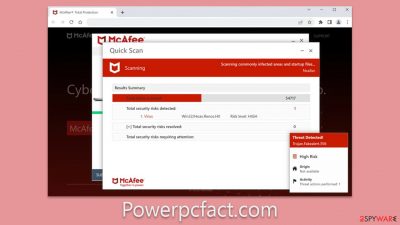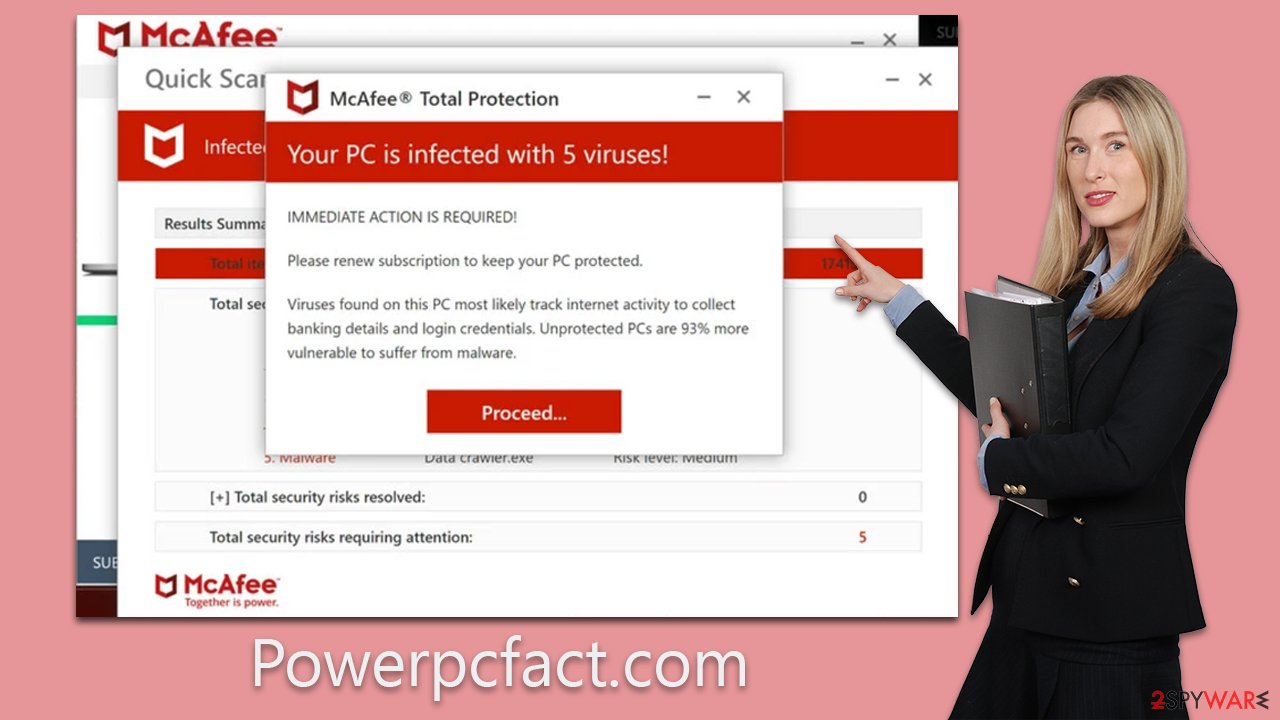Powerpcfact.com ads (scam) - Free Instructions
Powerpcfact.com ads Removal Guide
What is Powerpcfact.com ads?
Powerpcfact.com is a fake website designed by scammers

Powerpcfact.com is a scam website that employs deceptive tactics to trick users into purchasing software to remove fake malware infections. Upon visiting the site, users are greeted with a fake security scan that falsely claims their system is infected with viruses. The scam website often presents itself as affiliated with reputable security software such as McAfee anti-malware, but this is just a ploy to earn affiliate sales from software purchases.
Once on the site, users may be prompted to renew their subscription to the supposed security software to remove the fake threats. However, these claims are entirely fraudulent, and the security vendor has no association with the scam.
In addition to the fake security scan, Powerpcfact.com may also attempt to enable push notifications to users, which can serve as an additional source of income for scammers. It is important for users to refrain from interacting with any pop-up windows or notifications from the scam site.
If you encounter Powerpcfact.com or similar scam websites, it is crucial to avoid making purchases or providing personal or financial information. Instead, taking steps to remove any suspicious software or files from your system effectively and safely is recommended.
| Name | Powerpcfact.com |
| Type | Scam, fraud, phishing, redirect |
| Infiltration | Redirects from other websites, pop-up ads, potentially unwanted applications |
| Operation | The scam is based on scaring users into believing that their systems are infected and that they need to remove the allegedly found malware with promoted software |
| Dangers | Installation of PUPs or malware, sensitive information disclosure, financial losses |
| Removal | You should not interact with any links or ads shown on the scam page and shut it down immediately. Then, perform a full scan with SpyHunter 5Combo Cleaner security software as a precautionary measure |
| Other tips | Once you have removed all of the unwanted software, it is important to clean your web browsers and fix any corrupted system files. You can do that automatically by following the instructions here FortectIntego or referring to our manual guide. |
Powerpcfact.com may be associated with an adware infection
Powerpcfact.com may be associated with adware infections, which are a type of malicious software that displays unwanted advertisements and redirects users to malicious websites. Adware can often infiltrate users' systems without their knowledge or consent, typically through deceptive techniques such as bundled software installations or fake software updates.
Once the adware is installed on a system, it can manipulate web browsers and redirect users to websites like Powerpcfact.com, which then display false virus infection messages and prompt users to purchase software to remove the alleged malware. Adware can also generate pop-up ads or notifications that lead users to other malicious websites or fake anti-malware download pages.
Users may also be redirected to Powerpcfact.com or similar malicious websites after clicking on suspicious links or visiting high-risk websites, such as torrent sites, with higher chances of encountering malicious links or downloads.
It is important for users to be cautious when downloading and installing software, especially from unfamiliar sources, and to keep their systems and browsers updated with the latest security patches.

How scammers exploit people's fears
Once the animation of the security scan on Powerpcfact.com or similar scam sites is finished, users are typically presented with a fake message that claims their PC is infected with multiple viruses. The message may specifically mention the name of reputable antivirus software, such as McAfee Total Protection, to create a sense of urgency and legitimacy:
Your PC is infected with 5 viruses!
IMMEDIATE ACTION REQUIRED!
Your McAfee subscription has expired!
Renew now to keep your PC protected.
Viruses found on this PC most likely track internet activity to collect banking details and login credentials. Unprotected PCs are 93% more vulnerable to suffer from malware.
The scammers intentionally use fear and intimidation tactics to manipulate users into taking action without thoroughly evaluating the legitimacy of the situation. By creating a sense of urgency and portraying the dire consequences of malware infection, scammers aim to exploit users' emotions and push them into making impulsive decisions.
In reality, the claims made in the fake message are entirely fabricated, and the user's PC may not be infected with any viruses at all. The scammers use these false claims to create a sense of panic and urgency, leading users to believe that renewing their McAfee subscription or purchasing software is the only solution to protect their PC.
Furthermore, the statement that “unprotected PCs are 93% more vulnerable to suffer from malware” is likely a fabricated statistic designed to further intimidate users and prompt them to take immediate action. Scammers often use false or exaggerated statistics to create a sense of urgency and manipulate users into falling for their scam.
Checking the system for infections
It is crucial to check the system for infections after encountering scam messages, even if the claims made in the messages are proven to be bogus. As mentioned, adware is known for its ability to redirect users to phishing websites and expose them to intrusive ads, among other malicious activities.
Instead of relying on fake scan results or downloading unreliable software from scam messages, it is recommended to use reputable security tools to thoroughly scan and clean the system. Tools such as SpyHunter 5Combo Cleaner or Malwarebytes can effectively expose and remove malicious components from the system. Additionally, using FortectIntego can help to quickly get rid of leftover files, such as cookies used for tracking, and optimize the system for better performance.
Taking proactive measures to verify and clean the system from potential infections is essential to safeguarding personal information, protecting against further cyber threats, and ensuring the overall security and performance of the system.
Removing Powerpcfact.com ads
Upon entering the Powerpcfact.com site, users are immediately presented with a push notification prompt. While many users would typically decline this offer, some may accidentally click the “Allow” button. It is only later that they realize their screens are bombarded with intrusive pop-ups that display more misleading information, such as fake virus infections or get-rich-quick scams.
Similar to the website itself, it is not recommended to interact with these notifications or visit the websites they link to. If you have encountered this issue, it is important to follow the steps below to address it:
Google Chrome
- Open the Google Chrome browser and go to Menu > Settings.
- Scroll down and click on Advanced.
- Locate the Privacy and security section and pick Site Settings > Notifications.
- Look at the Allow section and look for a suspicious URL.
- Click the three vertical dots next to it and pick Block. This should remove unwanted notifications from Google Chrome.
![Stop notifications on Chrome PC 2 Stop notifications on Chrome PC 2]()
Mozilla Firefox
- Open Mozilla Firefox and go to Menu > Options.
- Click on Privacy & Security section.
- Under Permissions, you should be able to see Notifications. Click the Settings button next to it.
- In the Settings – Notification Permissions window, click on the drop-down menu by the URL in question.
- Select Block and then click on Save Changes. This should remove unwanted notifications from Mozilla Firefox.
![Stop notifications on Mozilla Firefox 2 Stop notifications on Mozilla Firefox 2]()
Safari
- Click on Safari > Preferences…
- Go to the Websites tab and, under General, select Notifications.
- Select the web address in question, click the drop-down menu and select Deny.
![Stop notifications on Safari Stop notifications on Safari]()
MS Edge (Chromium)
- Open Microsoft Edge, and go to Settings.
- Select Site permissions.
- Go to Notifications on the right.
- Under Allow, you will find the unwanted entry.
- Click on More actions and select Block.
![Stop notifications on Edge Chromium Stop notifications on Edge Chromium]()
How to prevent from getting adware
Choose a proper web browser and improve your safety with a VPN tool
Online spying has got momentum in recent years and people are getting more and more interested in how to protect their privacy online. One of the basic means to add a layer of security – choose the most private and secure web browser. Although web browsers can't grant full privacy protection and security, some of them are much better at sandboxing, HTTPS upgrading, active content blocking, tracking blocking, phishing protection, and similar privacy-oriented features. However, if you want true anonymity, we suggest you employ a powerful Private Internet Access VPN – it can encrypt all the traffic that comes and goes out of your computer, preventing tracking completely.
Lost your files? Use data recovery software
While some files located on any computer are replaceable or useless, others can be extremely valuable. Family photos, work documents, school projects – these are types of files that we don't want to lose. Unfortunately, there are many ways how unexpected data loss can occur: power cuts, Blue Screen of Death errors, hardware failures, crypto-malware attack, or even accidental deletion.
To ensure that all the files remain intact, you should prepare regular data backups. You can choose cloud-based or physical copies you could restore from later in case of a disaster. If your backups were lost as well or you never bothered to prepare any, Data Recovery Pro can be your only hope to retrieve your invaluable files.




